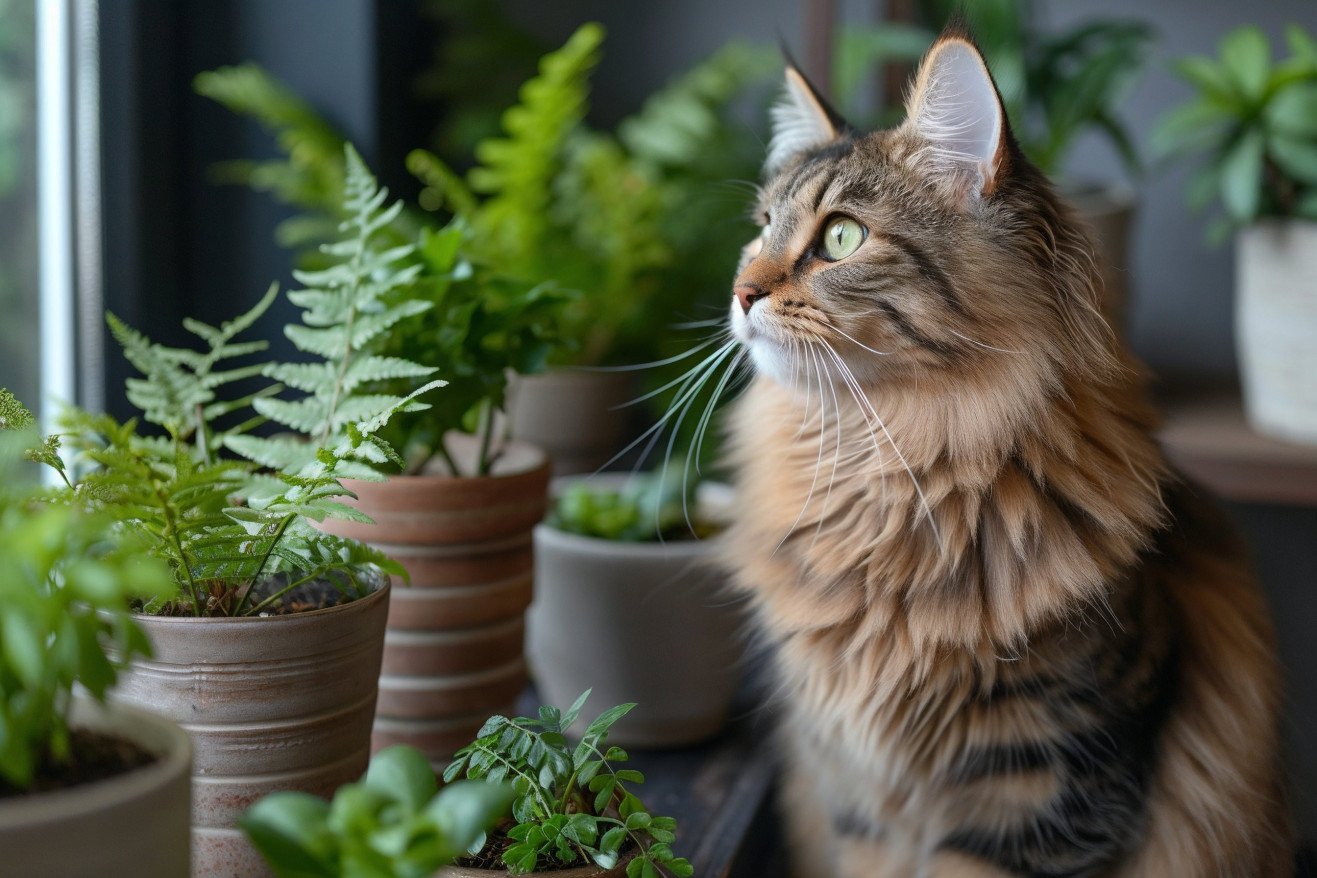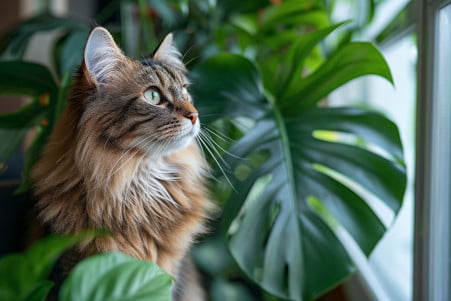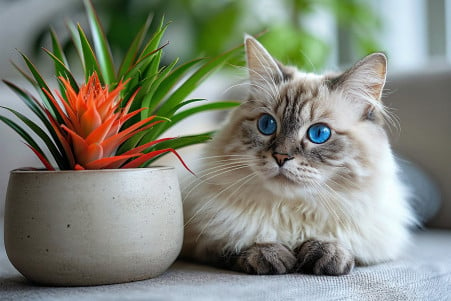Can Cats Eat Ferns? Understanding Plant Toxicity for Your Feline Friend
11 February 2024 • Updated 10 February 2024

If you have a cat, it’s important to know which plants in your home could be dangerous for your pet. Most true ferns, like the Boston and Maidenhair ferns, are non-toxic to cats. However, you still need to be careful because some fern-like plants, like the Asparagus fern, are poisonous to cats and can cause symptoms like vomiting, diarrhea, and skin irritation.
To help you better understand this issue and protect your pets, we’re going to take a deep dive into both botanical and veterinary research. This will involve looking at everything from research on plant toxicity to information about biological factors that impact cats’ ability to tolerate certain plants to advice from veterinarians.
By the end, you’ll have the information you need to make sure your cat is safe from any potential hazards your plants might pose to their health.
Are ferns toxic to cats?
How to Tell the Difference Between Toxic and Non-Toxic Ferns
If you want to have ferns in your home and you have a cat, you can make it work if you know how to tell the difference between toxic and non-toxic ferns. According to the ASPCA, true ferns like the Boston fern, Maidenhair fern, Sword fern, and Mother fern are non-toxic to cats.
Since these ferns don’t contain any toxic principles, they’re not likely to cause serious health problems if your cat chews on them.
That said, it’s important to know the difference between non-toxic ferns and toxic ferns to keep your cat safe. According to Rover.com, the Asparagus fern and Sprengeri fern, which are often called ferns, are not true ferns and are toxic to cats. If a cat eats these plants, it can cause vomiting and skin irritation.
To make sure you can recognize toxic ferns and keep them out of your home, you need to know what to look for. True ferns have delicate, bright green fronds and don’t have flowers or seeds. Instead, they reproduce by spores. On the other hand, toxic fern-like plants may have a different texture or growth habit and may have flowers or berries.
Shedding Light on the Dangers: Toxic Compounds in Plants
Cats are known for their curiosity and willingness to nibble on the plants in their environment. Unfortunately, some of the plants they may encounter contain toxic compounds that can be harmful to them. A study in PMC explains that plants produce a wide range of secondary metabolites, including alkaloids and saponins, as a defense against herbivores. These compounds can be toxic or deterrent to insects and other animals that feed on the plant.
In the case of cats, these plant toxins can cause a range of symptoms that are consistent with their toxic properties. When cats consume plants that contain these toxic secondary metabolites, they can experience vomiting, diarrhea, skin irritation, and other clinical signs.
A study in PMC even found that environmental conditions can have a significant impact on the concentration of toxic secondary metabolites in plants, which can, in turn, affect the severity of a cat’s response.
In addition to environmental factors, cats’ unique biology can also impact their response to plant toxins. An article in PMC notes that cats’ metabolic pathways can affect the way they metabolize specific compounds.
For example, cats’ limited ability to undergo glucuronidation—an metabolic pathway that helps the body break down substances—can make them more susceptible to certain plant toxins. Understanding these biological processes is important for identifying the potential risks that certain houseplants and fern-like plants may pose to cats.
How to Identify and Treat Fern Toxicity in Cats
If a cat has eaten a toxic fern, there are several symptoms that can help you identify the issue. According to Cats Protection, these symptoms include drooling, vomiting, diarrhea, seizures, difficulty breathing, and lethargy or unconsciousness. The cat may also experience skin irritation or swelling. If you think your cat has eaten a toxic plant, it’s important to act fast.
First, remove any plant material from your cat’s mouth and fur, and put your cat in a safe, enclosed area where you can monitor them closely. Then, call your vet immediately or contact a pet poison control hotline, according to PetMD. Do not try to make your cat vomit or treat them at home without consulting a professional.
Treatment for fern toxicity in cats usually involves decontamination like making the cat vomit or giving them activated charcoal to absorb the toxins, and supportive care like IV fluids, anti-nausea medication, and anti-inflammatory drugs. The sooner you get your cat to the vet, the better their chances of recovery.
To avoid this kind of emergency, be sure to carefully vet any plants you bring into your home or garden. Make sure all of the plants you have are non-toxic to cats, and make sure everyone in your household is aware of the dangers of toxic ferns. This way, you can help ensure that your cat is safe and free to explore without the risk of fern toxicity.
The Cat Metabolic Puzzle: Evolution and Plant Toxin Detoxification
The metabolic idiosyncrasies of cats play a major role in how they respond to plant consumption, especially in the digestion and detoxification of certain compounds. An article on PMC explains that cats are obligate carnivores and have evolved to metabolize primarily proteins and fats, with a limited ability to metabolize carbohydrates. This helps explain why cats may be more sensitive to plant toxins than other animals, like dogs, who have a more omnivorous diet.
One of the most important metabolic differences between cats and other animals is their limited ability to detoxify certain plant compounds. The liver enzymes of cats, which have been shaped by thousands of years of a high-protein, low-carbohydrate diet, are different from those of omnivores and may be less effective at detoxifying certain plant-based toxins.
An article on PMC also notes that cats’ status as obligate carnivores means they have a limited capacity for starch digestion and are less able to adapt to higher dietary carbohydrate levels, some of which may contain plant toxins.
These metabolic differences mean that cats have higher requirements for certain amino acids that are used in detoxification pathways. As explained in the Journal of Animal Science and Biotechnology, cats have higher endogenous nitrogen losses and amino acid requirements, which can affect their ability to detoxify plant toxins.
These metabolic differences are important to consider when determining the safety of plants for cats. While most true ferns are safe, fern-like plants may contain compounds that are difficult for a cat’s specialized digestive system to detoxify, which is why it’s important to choose plants carefully in homes with cats.
Veterinary Perspectives on Plant Toxicity and Cat Health
For cat owners whose cats have ingested a toxic plant, veterinarians are essential in the diagnosis and treatment of the issue. According to the Merck Veterinary Manual, this starts with a complete history and physical examination, and may include further diagnostic testing like blood work, urinalysis, and imaging to assess the level of toxicity and any potential organ damage.
Treatment can range from decontamination measures like inducing vomiting to the administration of activated charcoal, which can bind and inactivate toxins.
The case studies that are reported by the Pet Poison Helpline offer veterinarians and pet owners important information, showing just how serious plant toxicity can be and how important it is to get help as soon as possible. Veterinarians also focus on prevention, educating cat owners about which plants are safe and offering information that can help them find non-toxic plants to keep in their homes.
Because ingesting toxic plants can be a complicated medical issue, as "dvm360" points out, it’s important that veterinarians are able to identify the toxicant and start the appropriate treatment as soon as possible.
While this includes helping pet owners choose safe indoor plants, it also involves teaching them what to do in case of a poisoning emergency. This is just one way that veterinarians can take a proactive approach to ensuring the health and safety of cats, and it helps create a safer environment for cats.
Creating a Cat-Safe Garden at Home
Cat parents need to stay on top of things and take an active role in making sure their feline friends stay safe in a house full of plants.
The Healthy Pet Club says that the first step to preventing plant poisoning is to be aware of the plants that are toxic to cats and make sure they don’t make their way into your home.
Cats Protection suggests using lists that are approved by vets to help you figure out which plants are safe to bring into your home, like Christmas cactus and spider plants, and which ones to avoid, like lilies and daffodils.
An important part of this plan is being prepared for an emergency. If your cat does accidentally eat a toxic plant, it’s important to know the signs of plant poisoning and have a plan in place. The Healthy Pet Club says that if your cat has eaten any plant material, you should remove it from their mouth or fur right away and get them to a vet as soon as possible.
In addition, Blossom Blog points out that barriers, repellents, and creative ways of enclosing plants can help keep cats away from plants that could be toxic. By using these methods and making sure you’re informed, you can create an environment that’s safe for cats, full of greenery, and supportive of your cat’s health and well-being, which will help you avoid plant toxicity problems.
Keeping Your Cat Safe: The Bottom Line on Fern Toxicity
After delving into the topic of fern toxicity, we’ve learned that while true ferns like Boston and Maidenhair ferns are safe for cats, fern-like plants like Asparagus fern and Sprengeri fern are not. This makes accurate plant identification a top priority for cat owners who want to make sure their cats aren’t exposed to these potentially dangerous plants.
The importance of seeking veterinary treatment as soon as possible cannot be overstated; if your cat is experiencing signs of plant toxicity, like vomiting or skin rashes, getting them to the vet right away can be the difference between life and death. It’s also important to know the ways in which cats’ biological makeup makes them more susceptible to certain plant toxins.
With this knowledge and an abundance of caution when it comes to the plants we permit in our homes, we can ensure that our cats have a secure environment. Let’s ensure that the spaces we design for them are as safe as can be and that we can coexist peacefully with the plants we cherish.
With the right information and care, we can make sure that our cats stay healthy and happy in a world full of plants.


